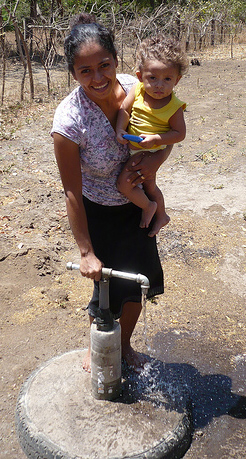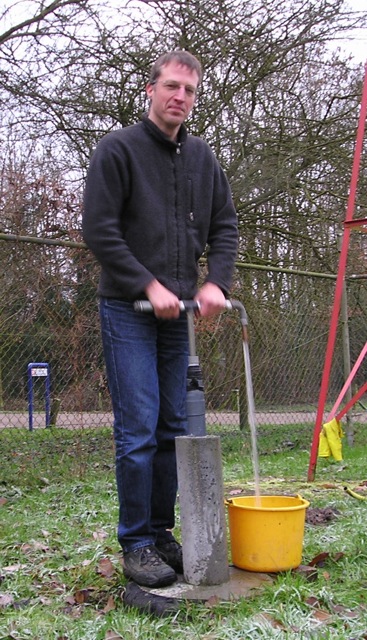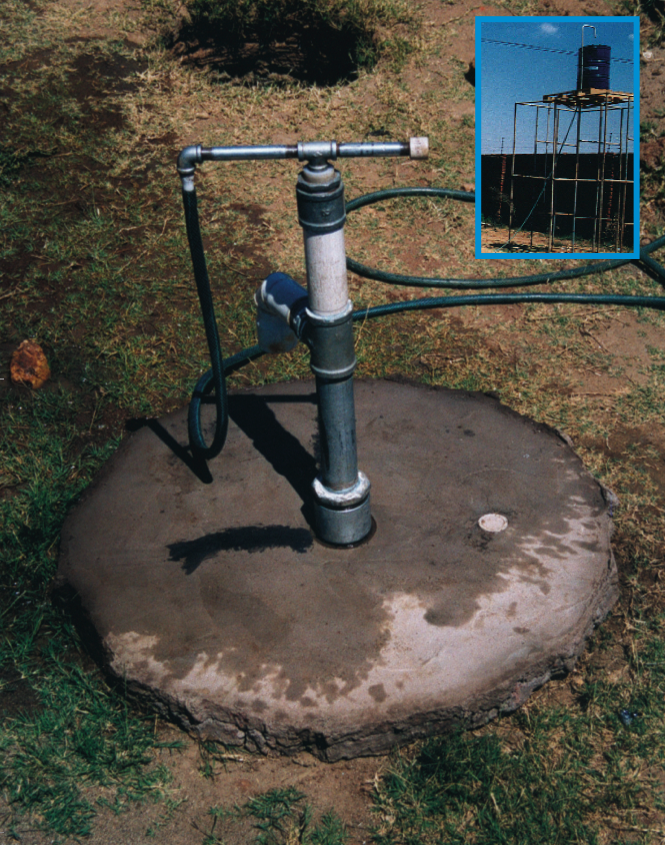Difference between revisions of "EMAS pump"
(→Suitable Conditions) |
|||
| Line 1: | Line 1: | ||
[[Image:Canzee_icon.png|right]] | [[Image:Canzee_icon.png|right]] | ||
| − | [[Image:diagram installation.jpg|thumb|right| | + | [[Image:Deep_well_pump.PNG|thumb|right|200px|EMAS type pump produced and used in Malawi. Photo: Netherlands Water Partnership.]] |
| + | [[Image:EMAS3.jpg|thumb|right|200px|An EMAS pump in Nicaragua, made by Paul Cloesen. More at [http://www.flickr.com/photos/paulcloesen/ Paul Cloesen Flickr stream] ]] | ||
| + | [[Image:EMAS1.jpg|thumb|right|200px|An EMAS pump at the WOT, University of Twente [http://www.wot.utwente.nl], the Netherlands.]] | ||
| + | [[Image:diagram installation.jpg|thumb|right|200px|Diagram of a set of water faucets around the house]] | ||
The EMAS pump is a very cheap PVC piston pump for family use, which can both pump water from a well and pump it to an elevated point. For example, it can pump water from 20 meters underground directly to an elevated tank another 20 meters above the ground level. The ability to pump directly to a storage tank avoids handling of the water, which avoids contamination. | The EMAS pump is a very cheap PVC piston pump for family use, which can both pump water from a well and pump it to an elevated point. For example, it can pump water from 20 meters underground directly to an elevated tank another 20 meters above the ground level. The ability to pump directly to a storage tank avoids handling of the water, which avoids contamination. | ||
Revision as of 21:37, 4 October 2012


The EMAS pump is a very cheap PVC piston pump for family use, which can both pump water from a well and pump it to an elevated point. For example, it can pump water from 20 meters underground directly to an elevated tank another 20 meters above the ground level. The ability to pump directly to a storage tank avoids handling of the water, which avoids contamination.
The EMAS pump compresses water between two one-way valves (check valves produced with glass marbles), a footvalve and a piston valve. Water is forced up the piston tube and comes out of the pump handle.
In many rural areas, people collect water used for domestic purposes from a central water source. These can be very far away from home, therefore collecting water takes up much time and energy on a daily basis. It is much more convenient to at least connect a distant pump to a local faucet for water in the kitchen, and if possible also for a shower. It also encourages better personal and domestic hygiene. This is possible using the EMAS pump, since it ejects water with the necessary pressure to transport it from its source up to an elevated distribution tank.
EMAS is the acronym for Escuela Móvil de Agua y Saneamiento (Mobile School for Water and Sanitation), in Bolivia, whose director, Wolfgang Eloy Buchner, developed the EMAS pump in the 1990's. EMAS is not only the name of the mobile school for water and sanitation, but also a whole technical and social concept of water and sanitation which includes rain water harvesting, solar water heaters, windpower, hydraulic rams, water treatment, small tanks and sinks, a variety of hand and foot pumps, and ferrocement tanks. The aim of the technologies and systems is to achieve the necessary supply of drinkable water, and water for micro irrigation in rural and sub urban areas.
Contents
Suitable Conditions
The EMAS pump is designed for household water supply at family level. Large diameter models can be used for small scale irrigation if the water is very superficial.
Several variants of the EMAS pump exist, such as adaptations to shallow wells (larger diameter, higher output), very high pressure (up to 60 m head) and foot-operated balancing devices. It can be coupled to windmills, children's seesaws, animal roundabouts etc. An EMAS pump can fit in boreholes as narrow as 1.25", which means that cheap, hand drilled boreholes are possible, such as with the Jetting - EMAS method.
EMAS pumps can be used to pump to a depth of 40-50 m. Deeper than 40-50 m, the pumping becomes very heavy. The EMAS pump can pump up to 30 l/min from a depth of 10 m, when operated by hand. Total production is up to about 5 m4/day. (That is: 5 m3 from 1 m depth or 0.5 m3 from 10 m or 250 l/day from 20 m depth etc.).
The lifespan of an EMAS pump can be estimated as 2 million liters pumped. PVC pumps are not as sturdy as metal ones. Ideally, they should serve a single family who owns and maintains it. Communal use is possible if maintenance and repair are well organized, but a single pump is not recommended to serve more than 100 people.
| Advantages | Disadvantages |
|---|---|
| - Comfort of having water supply in the house - Can pump directly into an elevated storage tank, avoiding water handling in buckets |
- Less resistant to very intensive use and mistreatment than metal pumps. - Output is on down-stroke. That makes it slightly more complicated to fit a lever or treadle. |
Construction, operations and maintenance
The EMAS pump and ferrocement tank need to be operated correctly.
Using a ferrocement tank and pipes, a shower and additional tap for laundry or kitchen usage can be installed. The tank is arranged on 4 solid wooden supporting beams at a height of about 2m. The distance between the beams should not exceed 80 cm. The shower can be installed under the tank by setting a plastic sheet around the beams to be used as a screen when taking a shower.
Further a laundry or kitchen basin is set up 80 cm high, and the faucet 1 meter high. The drain pipe is required with a diameter from 3/4" to 1 1/2". It has been observed that a 3/4" polyethylene hose is sufficient, and also very inexpensive. For the pipes to the faucet it is advisable to use PVC 1/2" pipes, with folding or coiled accessories. Accessories manufactured by hand will also be useful, since there is not much pressure in this system.
Costs
Field Experiences
Reference manuals, videos, and links
- How to build a kitchen sink http://vimeo.com/8454714


